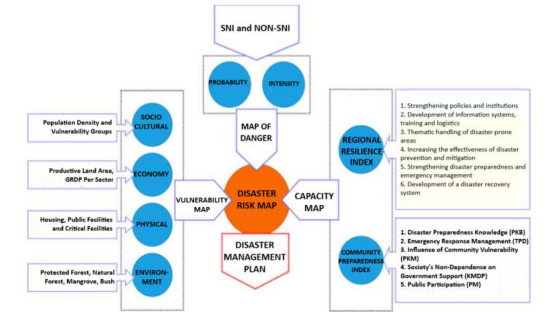
Submission to VIJ 2024-02-06
Keywords
- Risk Analysis,
- Earthquake,
- Central Lombok,
- Management,
- Disaster Mitigation
Copyright (c) 2024 Lalu Ahmad Murdhani, Erfan Wahyudi, Mujahidin

This work is licensed under a Creative Commons Attribution 4.0 International License.
Abstract
This research focuses on analyzing the risk of earthquake disasters in Central Lombok Regency for disaster management and mitigation purposes that can be implemented in the future. This disaster risk analysis has been prepared using a methodology adapted to the Regulation of the Head of the National Disaster Management Agency Number 02 of 2012 concerning General Guidelines for Disaster Risk Analysis, as well as referring to other guidelines applicable at national level ministries/institutions. Central Lombok Regency faces significant risks related to earthquakes, especially in the coastal, southern and central areas. The risk index value is obtained from data analysis related to the hazard, vulnerability and capacity components for each potential disaster grouped into 3 (three) levels/classes, namely 0-0.333 for low class, > 0.333-0.666 for medium class, and >0.666-1 for high class. The index values are different for each disaster, except for the regional capacity index which applies the same to all regions. The Central Lombok Regency disaster risk assessment was carried out at the village/sub-district level. Detailed results of the analysis of each disaster risk assessment index for all potential disasters in Central Lombok Regency are described for each component determining disaster risk assessment. The results of this research show that the highest risk of earthquake disasters is in East Praya at 31%, then the moderate disaster risk is in the Jonggat and Pringgarata areas at 65%, and the low risk is in the North Batuliang area at 68%.
References
- Tim Seismologi Teknik BMKG. (2018). Ulasan Guncangan Tanah Akibat Gempa Bumi Lombok Utara.
- Wekke, I. S., Rajindra, R., Pushpalal, D., Samad, M. A., Yani, A., & Umam, R. (2019). Educational Institution on Responding Disasters in Palu of Indonesia. INA-Rxiv Papers. https://doi.org/10.31227/osf.io/drc8q
- Hadi, H., Agustina, S., & Subhani, A. (2019). Penguatan Kesiapsiagaan Stakeholder Dalam Pengurangan Risiko Bencana Gempa Bumi. Jurnal Geodika, 3(1), 30–40
- Mildawati, M. (2018). Pengelolaan Sumberdaya K/L, NGO, Lembaga Usaha dan Bantuan Asing. In Pembelajaran Penanganan Darurat Bencana Gempa Bumi Lombok(pp. 241–275). Forum Perguruan Tinggi Pengurangan Risiko Bencana (FPT-PRB)
- BPBD Provinsi NTB. (2018). Dokumen Hasil Kaji Cepat Kebutuhan Pascabencana (Jitupasna) untuk Penanganan Bencana Gempa Bumi Tahun 2018
- Madjid, N. C. (2018). Analisis Metode Penghitungan Dan Alokasi Anggaran Bencana Alam. Simposium Nasional Keuangan Negara
- Karlina, R. (2021). Kesiagaan dalam Perencanaan Anggaran Penanggulanan Bencana Banjir di Kabupaten Bandung. Publica: Jurnal Pemikiran Administrasi Negara, 13(1), 52–67
- Satria, B. (2018). Sarana Dan Prasarana Pendukung Kesiapsiagaan Bencana Sekolah. Idea Nursing Journal, 9(1), 42–46
- Mushlih Adam. 2014. Ilmu Pengetahuan Sosial. Kemdikbud : Jakarta
- Jogiyanto. 1990. Manajen Sistem Informasi. Yogyakarta : Pustaka Pelajar
- Sutrisno. 1987 : Sistem Informasi. Yogyakarta : Pustaka Pelajar.